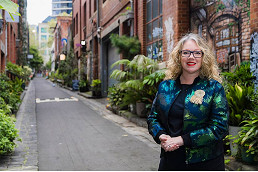The grandeur of Spring St, early autumn 1899
The wealth and extravagance of the 1880s, the era of Marvellous Melbourne, was long gone when this photograph was taken, but it is still evident in the two main buildings you see here – the Grand Hotel on the left and the Princess Theatre on the right.
The ornate Princess Theatre that dominates this streetscape gives no sense of the terrible fate that overtook Victorian society in the 1890s. The collapse of the banks and the suffering that followed overwhelmed almost every aspect of life. It is said that a third of Melbourne’s population was unemployed during this decade and many had nowhere to live.
This photograph from the Royal Historical Society’s extensive images collection was taken at the very end of the 1890s as people found work again and there was a renewed sense of optimism. The prospect of Australia becoming a nation brought with it a sense of anticipation and about 18 months after this image was taken, Federation celebrations were held throughout the country, especially in Melbourne, which at that time was the seat of the federal government.
The photograph was taken from the intersection of Nicholson and Spring streets looking south. Although undated, it appears to have been taken in summer or early autumn. No one is wearing a heavy jacket or coat, although the obligatory hats are in evidence, and the Princess Theatre is advertising the pantomime Forty Thieves, which played in Adelaide at Easter (early April) and opened in Melbourne towards the end of May 1899.
The stillness of this part of Spring St strikes the onlooker. Just around the corner and down Bourke St, there will be the hustle and bustle associated with the main shopping precinct. But here, on this broad and mostly empty thoroughfare there are just three horse-drawn carts, a few pedestrians and a cable tram.
Cable trams had been around for more than a decade when this photo was taken. The tram you see ran on the Clifton Hill line and was soon to turn the corner of Bourke St on its way to Spencer St. It is clearly labelled “Clifton Hill”, but the cable trams on specific routes were also allocated their own colour, important at a time when not everyone could read or write. Clifton Hill trams were red. Others were blue, green, yellow and white.
A horse cab is pulled over to the side of the road on the left-hand side of this scene (the Parliament House side). A hansom cab, perhaps? It is a reminder that just 13 years earlier a Melbourne hansom cab featured as the murder scene in the highly successful crime novel The Mystery of a Hansom Cab by Fergus Hume. An overnight sensation, this whodunnit took Melbourne to a broad global readership. It is still in print and was made into a television movie in 2012.
Opposite the horse cab is the Grand Hotel. Built in the 1880s in the Renaissance Revival style, it was one of Melbourne’s grandest hotels. It epitomised the opulence of Marvellous Melbourne. Like London’s Ritz and Savoy and the Raffles in Singapore, the rich and famous stayed there. It oozed luxury. Soon after it was built it was expanded, its liquor licence was torn up and it was transformed into the Grand Coffee Palace, but this was not to last and, liquor licence restored, it reverted to the Grand Hotel in 1897. The year after (and the year before this photograph was taken), the Federal Constitution was drafted at the hotel. By then, the Grand was financially secure. It is still there, known now as the Windsor Hotel (renamed in 1920), dubbed by some the “Duchess of Spring St”.
The star of this scene, though, is the Princess Theatre, designed in the French Second Empire style. The building dominates the streetscape, just as the theatre dominated Melbourne’s arts scene for more than a century. Completed in 1886, it replaced earlier theatres that dated back to the middle 1850s. The central pediment features a trumpeting angel, calling out to all who pass that Forty Thieves is not-to-be-missed entertainment. Based on the story of Ali Baba and the Forty Thieves, this was not mere pantomime. Promoted in the press as a “spectacular extravaganza”, this “very gorgeous production” began its run in Sydney the previous Christmas, went to Adelaide for Easter and was about to wow Melbourne audiences. It had a cast of more than a hundred, including the key players, chorus, ballet and extras. The Age newspaper noted that one of its most striking features was the inclusion of a series of patriotic tableaux ranging from the Death of Nelson to the Spanish Armada and the Capture of Manila.
So, in this one production the audience could bask in the triumphs of the British Empire while gasping at the “oriental” splendour on show •

A milestone for the mysterious






 Download the Latest Edition
Download the Latest Edition